伸展树作为BST的又一个派生类
其主要特色是没每插入或查找一个节点,会把该节点通过一次次的旋转伸展至树根,并且减少树高
使得用户经过一段时间的使用后
高访问频率的数据集中在树根位置,查询深度浅,速度快
从而达到提高效率的目的
因此相较而言,AVL树更像是循规蹈矩,如履薄冰。而伸展树则更加潇洒,不羁小节。
例如一颗这样的伸展树
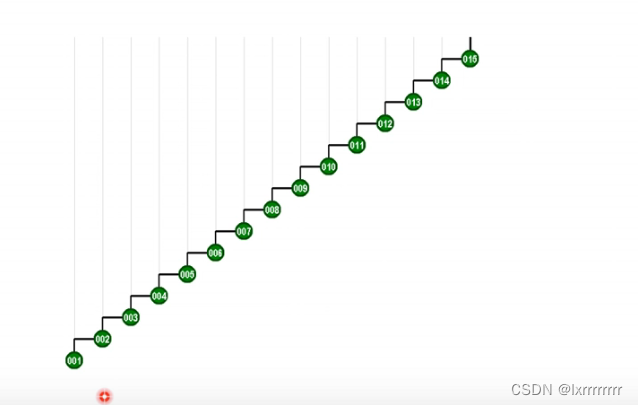
如果你访问001节点,即访问最底的节点
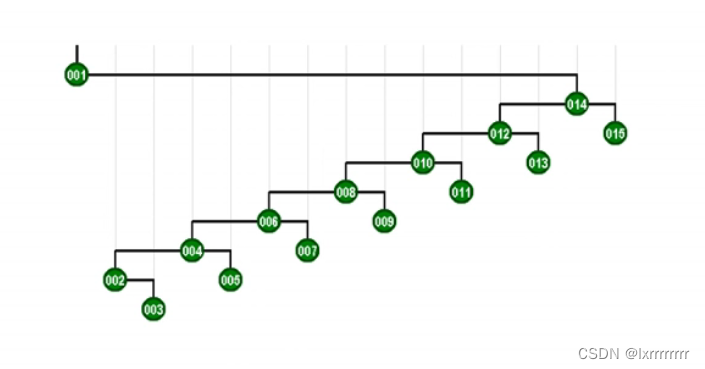
伸展树会把001伸展至根节点,同时缩短书高
在访问一次003节点
树会伸展至如下图结构
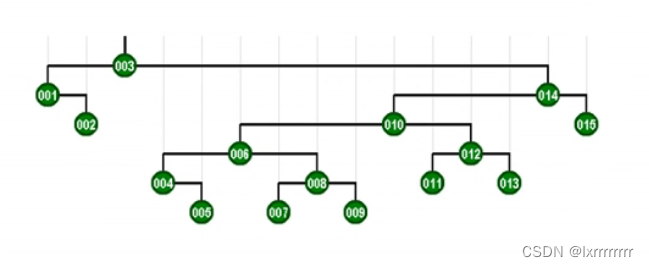
为方便理解,首先介绍几个旋转方式:
zig为顺时针旋转,zag为逆时针旋转,可以看到,经过这种单层旋转
可以将V节点提升一层
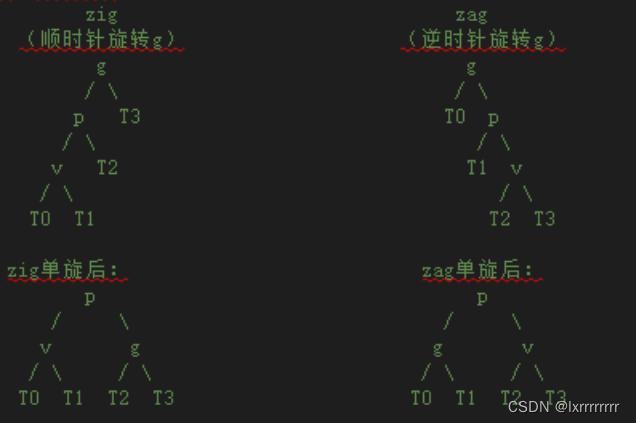
而两个单层旋转互相组合,可以有四种双层旋转
分别为zag-zag,zig-zig zig-zag zag-zig四种
其中zig-zig旋转:
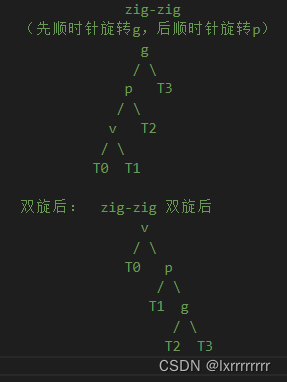
zag-zag旋转:
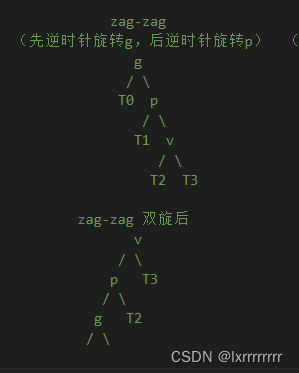
zag-zig旋转
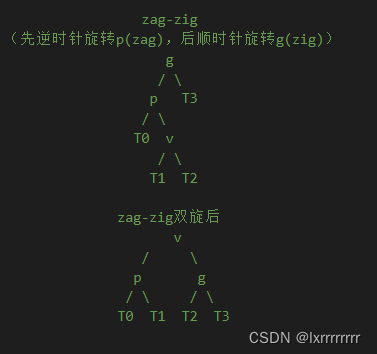
zig-zag旋转
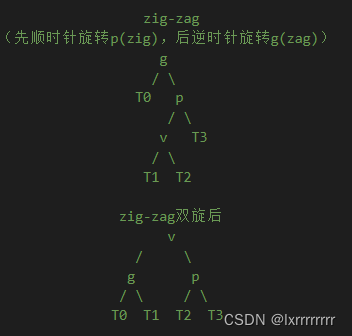
可以看到以上节点都把V提升了两层
似曾相似对不对
zig-zag和zag-zig就是上篇中平衡AVL树的3+4重构的转法
一会代码也会有所体现
为什么要引入双层旋转:
因为如果全采用单层旋转,那么顺序访问节点后会发现树高没有变,复杂度会飙到n方
类似下图
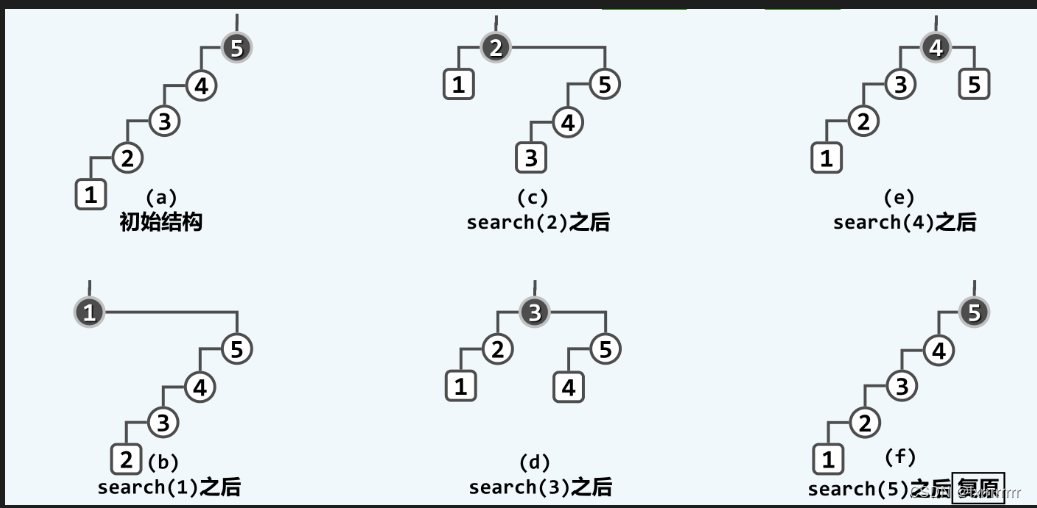
这里就不过多赘述推导过程了,可以去查下相关资料

只有双层旋转才可以有效减少树高,提升效率
经过以上分析,我们先把前置的旋转函数写以下
毕竟我们以前的代码是处理不了单旋,zigzig,zagzag这四种情况的
相信对于聪明的你这并不难写
代码如下
旋转
template <typename K,typename V>
lxrbinnodeposi(T) lxrSplayTree<K,V>::zig(lxrbinnodeposi(T) p){
lxrbinnodeposi(T) x=p->leftchild;
p->leftchild=x->rightchild;
if(x->rightchild) x->rightchild->parent=p;
x->rightchild=p;
p->parent=x;
this->updateHeight(p);
this->updateHeight(x);
return x;
}
template <typename K,typename V>
lxrbinnodeposi(T) lxrSplayTree<K,V>::zag(lxrbinnodeposi(T) p){
lxrbinnodeposi(T) x=p->rightchild;
p->rightchild=x->leftchild;
if(x->leftchild) x->leftchild->parent=p;
x->leftchild=p;
p->parent=x;
this->updateHeight(p);
this->updateHeight(x);
return x;
}
template <typename K,typename V>
lxrbinnodeposi(T) lxrSplayTree<K,V>::zigzig(lxrbinnodeposi(T) g){
lxrbinnodeposi(T) p=g->leftchild;
lxrbinnodeposi(T) x=p->leftchild;
p->leftchild=x->rightchild;
if(x->rightchild) x->rightchild->parent=p;
x->rightchild=p;
p->parent=x;
g->leftchild=p->rightchild;
if(p->rightchild) p->rightchild->parent=g;
p->rightchild=g;
g->parent=p;
this->updateHeight(g);
this->updateHeight(p);
this->updateHeight(x);
return x;
}
template <typename K,typename V>
lxrbinnodeposi(T) lxrSplayTree<K,V>::zagzag(lxrbinnodeposi(T) g){
lxrbinnodeposi(T) p=g->rightchild;
lxrbinnodeposi(T) x=p->rightchild;
p->rightchild=x->leftchild;
if(x->leftchild) x->leftchild->parent=p;
x->leftchild=p;
p->parent=x;
g->rightchild=p->leftchild;
if(p->leftchild) p->leftchild->parent=g;
p->leftchild=g;
g->parent=p;
this->updateHeight(g);
this->updateHeight(p);
this->updateHeight(x);
return x;
}有了以上基础我们就可以顺理成章写出伸展函数
Spaly
虽然代码看起来有些长,但大多数是分类讨论的内容
如果该节点只有父节点而没有祖父节点,那么只能进行单旋,如果他是左儿子就进行zig旋转
反之进行zag旋转
接下来如果x有祖父节点
那我们看他父节点和祖父节点的关系,他和他父节点的关系
按我们上面分析的关系分成四类
其中双左儿子/双右儿子需要进行我们的zigzig/zagzag旋转
余下两个进行3+4重构
按照此方法一直将x伸展至根节点
别忘了更新根节点和树高
代码如下
template <typename K,typename V>
lxrbinnodeposi(T) lxrSplayTree<K,V>::splay(lxrbinnodeposi(T) x){
lxrbinnodeposi(T) p;
lxrbinnodeposi(T) g;
lxrbinnodeposi(T) hot;
while(x!= this->__root){
p=x->parent,g=p->parent;
if(!g){
hot=p->parent;
x=(x==p->leftchild ? zig(p) : zag(p));
x->parent=hot;
if(hot) (p==hot->leftchild) ? hot->leftchild:hot->rightchild=x;
}
else{
if(p==g->leftchild){
if(x==p->leftchild){
hot =g->parent;
x =zigzig(g);
x->parent=hot;
if(hot) (g==hot->leftchild ? hot->leftchild : hot->rightchild)=x;
}
else{
hot =g->parent;
x =this->connect34(p,x,g,p->leftchild,x->leftchild,x->rightchild,g->rightchild);
x->parent=hot;
if(hot) g==hot->leftchild ? hot->leftchild : hot->rightchild=x;
}
}
else{
if(x==p->leftchild){
hot =g->parent;
x =this->connect34(g,x,p,g->leftchild,x->leftchild,x->rightchild,p->rightchild);
x->parent=hot;
if(hot) g==hot->leftchild ? hot->leftchild : hot->rightchild=x;
}
else{
hot =g->parent;
x =zagzag(g);
x->parent=hot;
if(hot) g==hot->leftchild ? hot->leftchild : hot->rightchild=x;
}
}
}
if(!x->parent) this->__root=x;
}
return x;
}写完了splay函数,伸展树就已经完成一大半了
剩下只要按照伸展树思想完成查找删除和插入函数即可
search
伸展树的search和BST差不多
只是再经过查找之后
我们要将返回的节点伸展至树根
如果返回的是空节点,那就将他的父节点伸展至树根,即__hot
代码如下
template <typename K,typename V>
lxrbinnodeposi(T)& lxrSplayTree<K,V>::search(K const &key){
lxrbinnodeposi(T) x=this->searchIn(this->__root,key,(this->__hot)=nullptr);
if(x) splay(x);
else if(this->__hot) splay(this->__hot);
return this->__root;
}insert
这里给出一种实现方式
直接调用上面伸展树的搜索算法,这样一次搜索必然会失败,但是此时`__hot`会被移动到根结点。我们可以直接比较待插入value与__hot的value的大小,从而直接将被插入结点插入到根结点。整个过程如下图所示:

代码如下:
template <typename K,typename V>
lxrbinnodeposi(T) lxrSplayTree<K,V>::insert(K const &key,V const &value){
lxrbinnodeposi(T) x=search(key);
if(x&& x->data.key==key) return x;
this->__root=new lxrbinnode<T>(entry<K,V>(key,value));
++(this->__size);
if(!x) return this->__root;
if(key < x->data.key){
this->__root->leftchild =x->leftchild;
this->__root->rightchild=x;
x->leftchild =nullptr;
x->parent =this->__root;
}
else{
this->__root->leftchild = x;
this->__root->rightchild = x->rightchild;
x->rightchild = nullptr;
x->parent = this->__root;
}
this->updateHeight(x);
this->updateHeight((this->__root));
return this->__root;
}remove
删除函数会比较复杂,这里给出一种实现方式
首先调用伸展树的搜索算法,这样被删除结点就已经被移动到了根结点,因此可以直接将根结点删除。接下来的问题是,应该由哪个结点来作为新的根结点。
在根结点没有左子树或者没有右子树时,可以直接用那棵唯一的子树来替代根结点,从而完成了根结点的删除。但在根结点同时具有左右子树时,根据伸展树的局部性原理,仍可选取被删除结点的直接后继来作为新的根结点,这样数据的局部性仍然可以得到应用。
为了将根结点的直接后继提升为新的根结点,可以在TR中再次查找根结点的关键码,尽管这次查找必然失败,却可以将TR中的最小结点提升为根节点。并且由于它是最小结点,根据BST的局部有序性,新的根节点必然没有左子树,从而可以将TL作为左子树与新的根结点进行连接。这样,就得到了一棵完整的二叉搜索树。整个过程如下图所示:
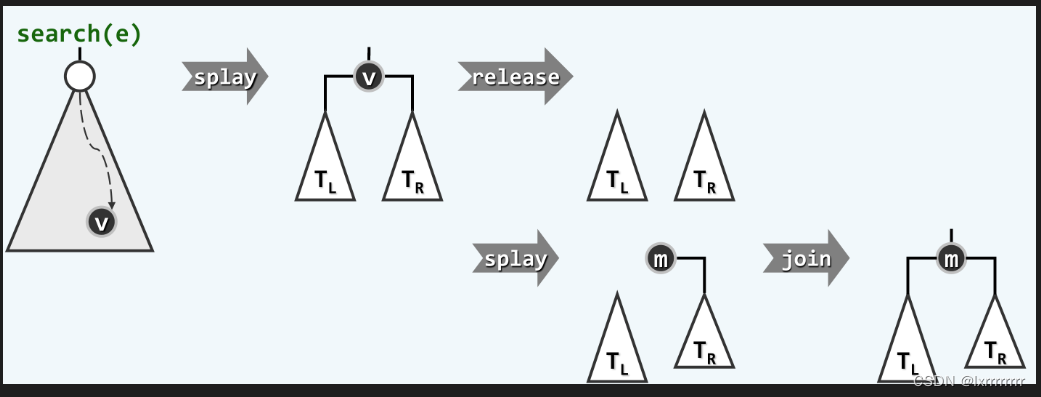
代码如下:
template <typename K,typename V>
bool lxrSplayTree<K,V>::remove(K const &key){
lxrbinnodeposi(T) x=search(key);
if(!x || x->data.key!=key) return false;
if(!(this->__root)->leftchild){
this->__root=this->__root->rightchild;
if(this->__root) this->__root->parent=nullptr;
search(key);
}
else if(!(this->__root)->rightchild){
this->__root=this->__root->leftchild;
this->__root->parent=nullptr;
search(key);
}
else{
this->__root=x->rightchild;
this->__root->parent=nullptr;
search(key); //move x's succ to root,
this->__root->leftchild=x->leftchild; //and __root has no left child(for succ has the smallest key
x->leftchild->parent=this->__root;
this->updateHeight(this->__root);
}
--(this->__size);
delete x;
return true;
}
完整代码
#ifndef LXRSPLAYTREE_H_
#define LXRSPLAYTREE_H_
#include "../05 BST/lxrBST.h"
#define T entry<K,V>
template <typename K,typename V>
class lxrSplayTree:public lxrBST<K,V>{
protected:
lxrbinnodeposi(T) splay(lxrbinnodeposi(T) x);
lxrbinnodeposi(T) zig(lxrbinnodeposi(T) p); //right rotation
lxrbinnodeposi(T) zag(lxrbinnodeposi(T) p); //left rotation
lxrbinnodeposi(T) zigzig(lxrbinnodeposi(T) g);
lxrbinnodeposi(T) zagzag(lxrbinnodeposi(T) g);
public:
lxrbinnodeposi(T)& search(K const &key);
lxrbinnodeposi(T) insert(K const &key,V const &value);
bool remove(K const &key);
};
//protected methods
template <typename K,typename V>
lxrbinnodeposi(T) lxrSplayTree<K,V>::splay(lxrbinnodeposi(T) x){
lxrbinnodeposi(T) p;
lxrbinnodeposi(T) g;
lxrbinnodeposi(T) hot;
while(x!= this->__root){
p=x->parent,g=p->parent;
if(!g){
hot=p->parent;
x=(x==p->leftchild ? zig(p) : zag(p));
x->parent=hot;
if(hot) (p==hot->leftchild) ? hot->leftchild:hot->rightchild=x;
}
else{
if(p==g->leftchild){
if(x==p->leftchild){
hot =g->parent;
x =zigzig(g);
x->parent=hot;
if(hot) (g==hot->leftchild ? hot->leftchild : hot->rightchild)=x;
}
else{
hot =g->parent;
x =this->connect34(p,x,g,p->leftchild,x->leftchild,x->rightchild,g->rightchild);
x->parent=hot;
if(hot) g==hot->leftchild ? hot->leftchild : hot->rightchild=x;
}
}
else{
if(x==p->leftchild){
hot =g->parent;
x =this->connect34(g,x,p,g->leftchild,x->leftchild,x->rightchild,p->rightchild);
x->parent=hot;
if(hot) g==hot->leftchild ? hot->leftchild : hot->rightchild=x;
}
else{
hot =g->parent;
x =zagzag(g);
x->parent=hot;
if(hot) g==hot->leftchild ? hot->leftchild : hot->rightchild=x;
}
}
}
if(!x->parent) this->__root=x;
}
return x;
}
template <typename K,typename V>
lxrbinnodeposi(T) lxrSplayTree<K,V>::zig(lxrbinnodeposi(T) p){
lxrbinnodeposi(T) x=p->leftchild;
p->leftchild=x->rightchild;
if(x->rightchild) x->rightchild->parent=p;
x->rightchild=p;
p->parent=x;
this->updateHeight(p);
this->updateHeight(x);
return x;
}
template <typename K,typename V>
lxrbinnodeposi(T) lxrSplayTree<K,V>::zag(lxrbinnodeposi(T) p){
lxrbinnodeposi(T) x=p->rightchild;
p->rightchild=x->leftchild;
if(x->leftchild) x->leftchild->parent=p;
x->leftchild=p;
p->parent=x;
this->updateHeight(p);
this->updateHeight(x);
return x;
}
template <typename K,typename V>
lxrbinnodeposi(T) lxrSplayTree<K,V>::zigzig(lxrbinnodeposi(T) g){
lxrbinnodeposi(T) p=g->leftchild;
lxrbinnodeposi(T) x=p->leftchild;
p->leftchild=x->rightchild;
if(x->rightchild) x->rightchild->parent=p;
x->rightchild=p;
p->parent=x;
g->leftchild=p->rightchild;
if(p->rightchild) p->rightchild->parent=g;
p->rightchild=g;
g->parent=p;
this->updateHeight(g);
this->updateHeight(p);
this->updateHeight(x);
return x;
}
template <typename K,typename V>
lxrbinnodeposi(T) lxrSplayTree<K,V>::zagzag(lxrbinnodeposi(T) g){
lxrbinnodeposi(T) p=g->rightchild;
lxrbinnodeposi(T) x=p->rightchild;
p->rightchild=x->leftchild;
if(x->leftchild) x->leftchild->parent=p;
x->leftchild=p;
p->parent=x;
g->rightchild=p->leftchild;
if(p->leftchild) p->leftchild->parent=g;
p->leftchild=g;
g->parent=p;
this->updateHeight(g);
this->updateHeight(p);
this->updateHeight(x);
return x;
}
//public interfaves
template <typename K,typename V>
lxrbinnodeposi(T)& lxrSplayTree<K,V>::search(K const &key){
lxrbinnodeposi(T) x=this->searchIn(this->__root,key,(this->__hot)=nullptr);
if(x) splay(x);
else if(this->__hot) splay(this->__hot);
return this->__root;
}
template <typename K,typename V>
lxrbinnodeposi(T) lxrSplayTree<K,V>::insert(K const &key,V const &value){
lxrbinnodeposi(T) x=search(key);
if(x&& x->data.key==key) return x;
this->__root=new lxrbinnode<T>(entry<K,V>(key,value));
++(this->__size);
if(!x) return this->__root;
if(key < x->data.key){
this->__root->leftchild =x->leftchild;
this->__root->rightchild=x;
x->leftchild =nullptr;
x->parent =this->__root;
}
else{
this->__root->leftchild = x;
this->__root->rightchild = x->rightchild;
x->rightchild = nullptr;
x->parent = this->__root;
}
this->updateHeight(x);
this->updateHeight((this->__root));
return this->__root;
}
template <typename K,typename V>
bool lxrSplayTree<K,V>::remove(K const &key){
lxrbinnodeposi(T) x=search(key);
if(!x || x->data.key!=key) return false;
if(!(this->__root)->leftchild){
this->__root=this->__root->rightchild;
if(this->__root) this->__root->parent=nullptr;
search(key);
}
else if(!(this->__root)->rightchild){
this->__root=this->__root->leftchild;
this->__root->parent=nullptr;
search(key);
}
else{
this->__root=x->rightchild;
this->__root->parent=nullptr;
search(key); //move x's succ to root,
this->__root->leftchild=x->leftchild; //and __root has no left child(for succ has the smallest key
x->leftchild->parent=this->__root;
this->updateHeight(this->__root);
}
--(this->__size);
delete x;
return true;
}
#undef T
#endif
但是伸展树并不能保证单次最坏情况的发生,所以不能适用于对效率非常敏感的场合,例如一些安全装置,应急装置,毕竟谁也不敢当赌怪






















 789
789











 被折叠的 条评论
为什么被折叠?
被折叠的 条评论
为什么被折叠?








